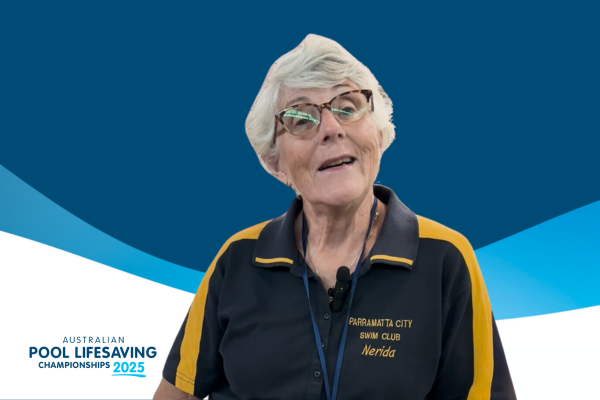Published 12 February 2025

Sixty-five years ago, Nerida Murray won what is now called the Super Lifesaver event at the Australian Pool Lifesaving Championships. Last month, she watched the same event being swum at the 2025 championships. We had the opportunity to speak to Nerida about her lifesaving sport journey.
“I’m not competing this year,” she laughed, “the mannequins are too heavy for me now.” Attending the championships with her daughter and granddaughter, the nearly 80-year-old was diligently recording times for their club, Parramatta City Swim Club. “I can still do the obstacles though. The swimming and the diving are not a problem for me.”
Nerida’s lifesaving journey began in the 1960s, when she represented New South Wales in two state teams. “That was 1961 and 1963,” she recalls. “I swam with East Hills Life Saving Club until I was 24.”
Then in 1968, she won the first ever Super Lifesaver event. “It was a swim similar to the diploma award at that time, and it has been competed for ever since,” she told us. “And I managed to be at the presentation this year. Isn’t that wonderful?”
The sport has changed a lot since that first event, “I can’t get over the flippers and the underwater work,” Nerida said. “Seeing people going 50 metres, picking up a mannequin, and going back without taking a breath – it’s just amazing what they do.”
“You've got to be accredited to swim, you've got to have your Bronze Medallion. It’s some very important skills,” she told us, highlighting the link with real world lifesaving skills and knowledge. “Everybody should know the basics. Everybody should be able to help save a life.”
Currently, Nerida swims for Blue Mountains Pheonix Masters. “I’ve been involved in Masters swimming since I was 50, so that’s nearly 30 years.” And how does she manage to keep swimming and competing? “Keep on going. That is the secret,” she said. “If you don’t use it, you lose it.”
“You just keep swimming. It depends how far you want to go and how much work you're prepared to do. And if you want to go far, you've got to be prepared to do the work.”
Thank you to Nerida Murray for telling us your story!
